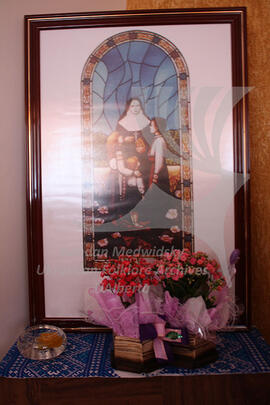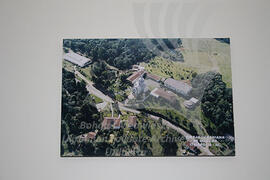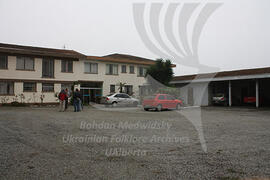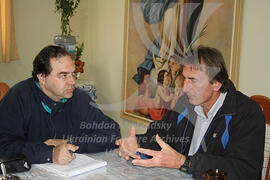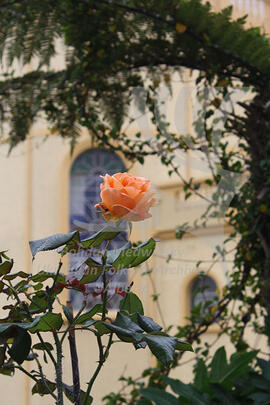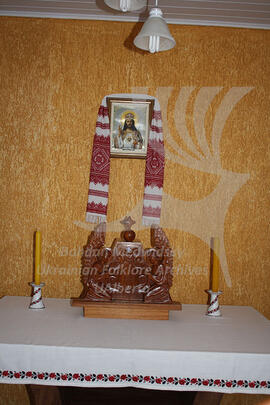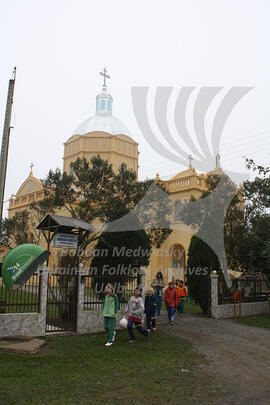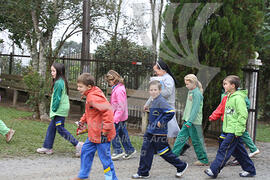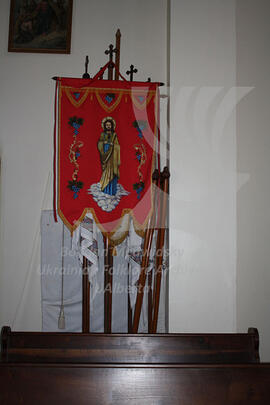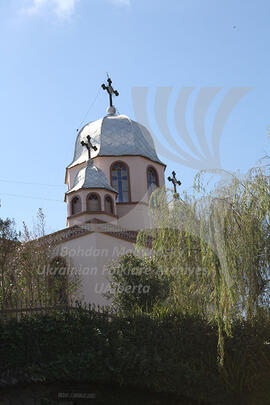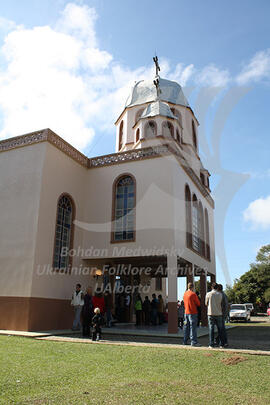The picture of the Sister Servant placed in the Chapel in the House of Sisters Servants, Craveiro, flowers
churches
263 Archival description results for churches
This collection contains the results of two ethnographic trips to the Ukrainian communities in Brazil by Andriy Nahachewsky. The first trip took place from 4 May to 26 May 2009, and included Andriy Nahachewsky, Serge Cipko, John C. Lehr, and Maryna Hrymych. This was the first trip to Brazil for each of the participants, though they each had strong credentials in their disciplines and in fieldwork more generally. Thus the project goal was to cast a wide net for general orientation into the historical and contemporary life of the Ukrainian communities there. Each researcher also had specific personal goals. The trip included visits to Curitiba, Prudentópolis and several rural communities nearby, Craveiro in Santa Catarina, São Paulo, Brasília, and Foz do Iguaçu. The agenda included visits to an agricultural cooperative, meetings with diplomats and organizational representatives, and diverse individuals who could speak about life in their communities. Photographs by Hrymych, Lehr, and Cipko are also accessioned into the BMUFA and located in their own respective collections.
The second trip was undertaken by Andriy Nahachewsky, for 6 months from 14 November 2009 to 13 May 2010. The goal of the project was to continue the first exploratory fieldtrip, intensifying and expanding it. The project had a strong diachronic focus, documenting change in cultural traditions, to understand better how Ukrainian cultural content, rooted in 19th century rural traditions in western Ukraine, became transplanted, disappeared, adapted, and sometimes newly created in its diaspora setting in the Brazilian context. The intent was to be able to compare these processes with similar ones known from the Ukrainian Canadian context, as well as culture in western Ukraine itself, which also changed significantly over the 20th century: One cultural root, and three branches evolving on three continents over 120 years.
Another aspect of the fieldtrip was connected with Nahachewsky’s earlier “Local Culture and Diversity on the Prairies” project, which strove to provide documentation about regional differences in traditional Ukrainian culture in the Canadian setting. This аspect of the project was to try trace local differences in Brazilian culture in a similar way. Some of these regional differences were probably most clear in past decades. A third aspect was more synchronic, aimed to document contemporary life. Connected with this, the Brazil trip involved travelling to some 65 communities in the states of Paraná, Santa Catarina, Rio de Janeiro, and São Paulo, the main Ukrainian settlement areas in Brazil. The project involved recording some 300 audio interviews, 53 hours of video recordings of contemporary events, 14,000 photographs, and gathering many publications and manuscripts (in hard copy and reproduced digitally), as well as diverse artifacts. The overall focus in subject matter was broad, including material culture (farming practices, folk arts), customs (calendar holidays, weddings, funerals, etc) and performing arts (music, dance). Special foci developed for dance materials, religious images, church architecture, cemeteries, music, and weddings, because of Nahachewsky’s research background, opportunities, and experiences as the fieldwork proceeded. The trips were both funded by the Huculak Chair and the Kule Folklore Centre (for the first trip: Nahachewsky, Hrymych, and various shared expenses). During both trips, the hosts in the home base in Prudentópolis, as well as other locations in Brazil, were very warm and hospitable, open, and generous. A copy of the digital photo, audio, and video fieldwork materials was deposited in the Museu do Milênio in Prudentópolis.
Nahachewsky, AndriyThe essay discusses cultural change on the example of Ukrainian Orthodox church. He compares prescribed church canon with what exists in the chapel in St. John's Institute looking specifically at the layout of the building, the placement of religious objects and the placement of pictures and icons in the chapel. Written for the course Ukrainian 326.
"Baba's Church; My Church" describes the history of the establishment of two Ukrainian Catholic churches across the street from each other in Winnipeg.
Fingarsen, FrankThis item contains two interviews with unknown females. The first interviewee was born in Russia in 1909. She talks about the place where she lived and family members that were starving and being deported to Siberia. She then talks about coming to Canada and what she and her husband did in Canada. She talks about the church and being Lutheran and Evangelic.
The second interviewee's parents came from Poland and she was raised in a Lutheran family. Her family left to Ukraine and then came to Canada in 1927 and moved to Alberta in 1928.
The tape also contains music recordings
The picture of the Ukrainian Catholic complex: Basilian Brothers' Monastery, The Sisters Servants' House and the Church. Photo is made from air.
The general view of Iracema Basilian Fathers' Monastery with the garage
Serge Cipko is interviewing Basilian brother Sergio
Fragment of the Basilian monastery flower garden with Ukrainian catholic church in the background
The altar of House of the Sisters Servants Chapel in Craveiro with different ritual objects (church objects, embroidery, icon, wooden sculpture)
The interior of House of the Sisters Servants Chapel in Craveiro with different ritual objects (church objects, embroidery, icon, picture)
The altar of House of the Sisters Servants Chapel in Craveiro with different ritual objects (church objects, embroidery, icon, wooden sculpture)
The group of Ukrainian children just finished their Ukrainian cathehism lessons in the Sagrada familia Iracema Church
The group of Ukrainian children are going to Sagrada familia Iracema Church for Ukrainian cathehism lessons
The group of Ukrainian children are going to Sagrada familia Iracema Church for Ukrainian cathehism lessons
Ascension of Our Lady Church in Craveiro and "Gruta Nosa Senhora de Lordes"
Church banner, embroidery of the Sagrada familia Iracema Church, Santa Catarina.
Ascension of Our Lady Church in Craveiro
Domes of the Ascension of Our Lady Church in Craveiro
Porch of the Ascension of Our Lady Church in Craveiro
